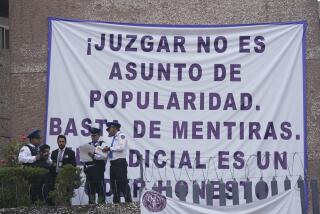Visual Aids : Foreign-Language Speakers Who Are Blind or Sight-Impaired Learn to Make Senses of English in Anaheim
Roberto Lopez steps up his pace. After months of hard work and study, he’s not about to lose ground by being late to class now.
Lopez, 28, who moved to Anaheim from Mexico four years ago, is learning to speak English. Like many learning it as a second language, he is driven by the desire to communicate better and succeed in his new country.
But his level of commitment--like that of his classmates at the Braille Institute in Anaheim--might be out of the ordinary. Lopez is blind. He must learn to speak his new language without seeing words or the objects and actions they represent.
Tapping his red-tipped cane on the sidewalk in front of him as he nears his bus stop, Lopez wears the smile of a man glad to be going where he’s going. At his destination, the warm welcome from his classmates makes it clear that he does not face his challenges alone.
Lopez, who lost his sight in a horseback riding accident when he was a child, is among two dozen visually impaired students who attend English as a Second Language classes at the institute. The students, ages 22 to 65, come from many countries and speak many languages.
“Being foreign without translation is difficult,” says James Jung, who came to the United States from Korea two years ago. “It is more of a problem to me than being blind.”
The English as a Second Language program was begun at the institute just over a year ago, and classes are offered four days a week. They are free of charge to the visually impaired and blind, as are other educational programs at the institute, which is one of six Southern California centers of the L.A.-based Braille Institute.
Julie Fosselman at the L.A. center says the Orange County program is the most innovative of the regional ESL programs, which are believed to be the only of their kind in the country.
Pam Breyer of Yorba Linda teaches the classes at the Anaheim center.
Breyer is the author of a number of ESL instruction books and has taught in Spain, Colombia and on U.S. campuses including Rutgers University in New Jersey and Columbia University in New York. All her previous work was with sighted students.
When she took on the assignment at the institute in 1995, Breyer knew she had to figure out ways to teach to students unable to see the words, sentences and pictures in traditional ESL textbooks.
“Those of us who have good vision rely on vision as a reinforcer all the time,” she says.
The key to learning language for the visually impaired: using the other senses to stimulate word associations. Breyer is developing ESL techniques that draw strongly on the senses of touch, hearing, smell and taste.
The only language spoken in class is English, and learning is experiential, not a matter of translation. To learn the word “book,” her students must hold one and remember what it is called.
Breyer uses a variety of learning tools and props--including perfume and food--and has created “sound stories” on audiocassettes. She plays a sequence of sounds--from alarm clocks going off to dishes being washed--to tell a story without words. Students use the tapes in class and at home to practice vocabulary and sentence structure.
On a recent morning, nine intermediate ESL students gathered around a table while Breyer placed a suitcase in the middle.
“I am going on a trip to San Francisco. It will be about 50 degrees there, and I will be staying in a fancy hotel,” she tells them.
Taking a swimsuit out of the suitcase, Breyer hands it to student Ramesh Modha, 33, an Anaheim resident who came from India two years ago.
“It is a bathing suit,” he says, concentrating on sentence construction. “You shouldn’t take your bathing suit because it will be too cold.”
“Very good, Ramesh,” says Breyer, passing a passport from the suitcase to Jung, 38. He identifies the item and forms a sentence in English.
“You don’t need a passport because the trip is local,” he says.
As the lesson continues, it is clear that Breyer’s method of “hands on” teaching is working. The students joke and smile with pride.
“We laugh. We have a very good time,” says student Elena Gruz, 29,whose husband, Alex, is also blind but is not in the class.”I like it because I want to live life better.”
Breyer says she will take lessons that she has learned from her class to others she teaches.
“The more senses you involve, the better you’re able to retain,” she says. “It’s changed my whole idea about the way I would teach sighted people.”
Her program at the Braille Institute began with two students, growing steadily to the current 25.
Three students have passed the test for U.S. citizenship, and others are preparing for it.
Each student has dreams.
Gruz of Placentia wants to work with computers; Julio Damian, 28, of Anaheim wants to become a day-care teacher; Modha, whose wife remains in India, wants to open a grocery store, and Jung wants to continue singing gospel music here and in Korea.
“When I came to the United States, I wanted to learn English in every way,” Jung says. “It makes me feel great, and I love it. I have confidence.”
Breyer says her students diligently attend class--some three days a week for four hours--and practice their lessons at home.
“They are very dedicated,” she says. “These students have two major strikes against them, and they rarely miss a class. That tells me something.”
Although learning a new language is difficult, Breyer says, her students seem to experience less frustration in the classroom than many sighted students she has taught.
Damian says he believes that sight loss is a challenge that creates strength. He was told after awakening from a five-day coma two years ago that he would go blind.
“When I woke up, I didn’t even know my name,” says Damian, who had been injured in a car accident. “Now I’m learning well and helping other people. I feel better.”
His positive outlook is shared by many of his classmates.
After class, the students head home.
Some live near the institute and walk to and from class; others get rides or rely on city buses.
Lopez turns his face skyward and smiles as he heads toward his bus stop. He is relieved that it’s not raining--managing a cane and an umbrella is not easy when you have to make two bus transfers.
“I see him walking to the bus almost every day,” says a woman at the bus bench. “He’s always smiling. Being blind and all, well, it’s nice to think that he has something to be so happy about.”
*
The Braille Institute is at 527 N. Dale Ave., Anaheim. (714) 821-5000.
More to Read
Sign up for Essential California
The most important California stories and recommendations in your inbox every morning.
You may occasionally receive promotional content from the Los Angeles Times.






